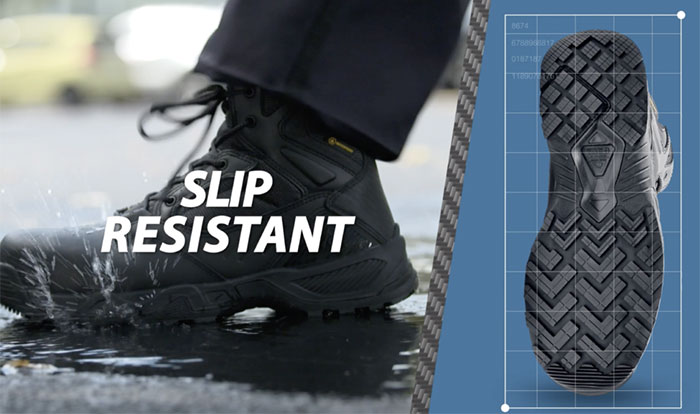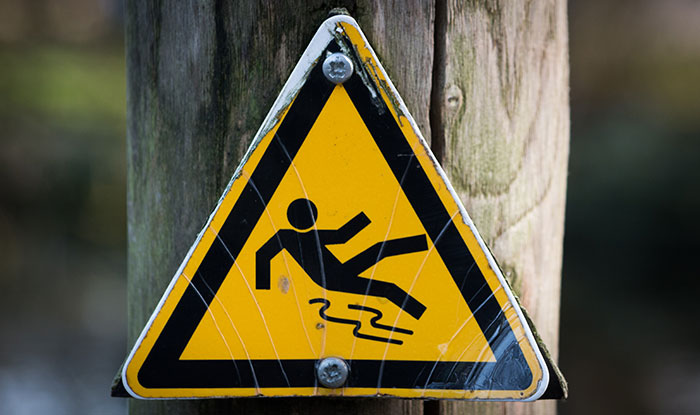OSHA’s Protective Footwear Rules: Who Pays?
Who Pays for OSHA Protective Footwear Requirements
In the U.S., the Department of Labor's Occupational Safety and Health Administration (more popularly known as OSHA) sets national standards for employee workplace safety. For example, OSHA requires employers in particular industries to provide employees with protective personal equipment, including footwear. Whether your company must comply with these mandatory OSHA shoe requirements depends on the risks inherent in job descriptions and work environments.
Keeping your company in compliance with OSHA’s regulatory standards for your industry is not the only consideration when it comes to mitigating the impact of workplace accidents. Accidents affect the worker both physically and financially. Protective footwear goes a long way toward reducing direct and indirect workers’ compensation costs which impacts the employer's bottom line.
The following article briefly describes OSHA protective footwear guidance and suggests ways you can comply with those standards in a way that results in cost savings.
When Does OSHA Require Protective Footwear?
OSHA requires that every business assess the workplace safety hazards in its facilities to determine whether the rules require its employees to wear protective personal equipment (PPE). Protective footwear is one type of PPE OSHA requires in certain industries.
The protective footwear rules are of particular importance in the following industries:
-
OSHA Footwear Requirements for Warehousing
-
OSHA Footwear Requirements for Supermarkets
-
OSHA Footwear Requirements for Healthcare
-
OSHA Footwear Requirements for Hospitality
-
OSHA Footwear Requirements for Manufacturing
-
OSHA Footwear Requirements for Food Service
-
OSHA Footwear Requirements for Schools
Various safety hazards require different types of protective footwear. The following are a few examples of different types of protective footwear:
Warehouses may require steel-toe boots to protect employees' feet from the impact of rolling equipment;
Electricians may need to wear composite toe boots (made from non-metal materials like Kevlar or fiberglass) to protect their feet from electrical hazards; and
Kitchens may require puncture-resistant boots or toe caps made of steel or compound materials to protect workers' feet from sharp instruments, like knives, that may fall on their feet as they work.
What Are OSHA's General Footwear Requirements?
ASTM is the acronym for the American Society for Testing and Materials, now known as ASTM International. ASTM advances safety standards and guidance for "manufactured goods, systems, processes, and services."
In the U.S., all occupational safety footwear must meet the ASTM standards and follow their guidelines. OSHA bears the responsibility to enforce ASTM guidance.
To demonstrate compliance with protective footwear rules, OSHA set out the following criteria:
ASTM F-2412-2005 - Standard test methods for foot protection that measures the resistance to various hazards; and
ASTM F2413-2005 - Standard Specifications for Performance Requirements for Protective Footwear that prescribes "fit, function, and performance for footwear" designed to address workplace safety hazards..
What Is ASTM F2413-18?
ASTM F2413-18 is the safety standard that applies to footwear made with a toe cap when the toe cap is a permanent and fundamental part of foot protection. The standard provides that manufacturers of this product must evaluate how the product performs with respect to resisting impacts.
This standard requires the protective footwear to demonstrate the following criteria to resist:
-
Electrical hazards
-
Punctures
-
Damage to metatarsal bones, those bones that connect your ankle to your toes
-
Impacts from safety hazards
-
Caustic or scorching materials
-
Conductivity
-
They also require protective footwear to disperse the effects of static electricity in hazardous workplaces.
So, When Are Times Employers Must Pay for OSHA Approved Safety Shoes?
OSHA's regulatory guidance also determines whether your company bears the full cost of the mandatory safety shoes or whether you can split that cost with your employees. Whether your company has to pay for the safety shoes for your employees depends on two things:
Results of your safety hazard assessment, and
Whether OSHA considers the safety shoe a "specialty product."
OSHA has mandated employers to pay for protective footwear since 2008 in those situations where OSHA safety shoe requirements necessitate fulfilling footwear standards.
In general, you cannot require your employees to pay for their PPE. And you must pay to replace PPE as long as your employees did not intentionally lose or damage the equipment, such as the safety shoes. The exception to that rule is that employers are not required to pay for protective footwear if the hazard assessment does not require safety shoes.
So, When Do Employers NOT Have to Pay for Safety Shoes?
Certain situations do not require employers to pay for safety shoes, for instance:
Employers do not pay for non-specialty safety-toe protective footwear if the employer allows employees to wear the shoes off-site.
Employers do not have to pay for steel-toe boots, but OSHA requires employers to pay for protective footwear required for special uses on the job.
For example, while employers do not pay for steel-toe boots, they must pay for rubber steel-toe boots designed and required to fulfill OSHA standards.
In addition, if an employer provides metatarsal guards and an employee requests to use shoes that have built-in metatarsal protection, OSHA does not require the employer to pay for those safety shoes with the built-in metatarsal protection.
Should Employers Pay for Non-specialty Safety Shoes?
The decision on whether you should provide non-specialty safety depends on the impact on the company's direct and indirect cost savings under Workers' Compensation.
Employees use safety protective shoes at a lower rate when employers do not share at least part of the cost. As employers increase their cost-sharing with respect to protective shoes, employees are more likely to purchase and wear non-specialty safety shoes.
There's another alternative to cost-sharing safety shoe expenses. Employees are more likely to increase their participation in protective shoes if the employer allows multiple payroll deductions, rather than via personal credit card expenses.
This cost-sharing concept is one reason for the popularity of corporate safety shoe programs.
Why Use a Corporate Safety Shoe Program?
A corporate safety shoe program provides your company with access to corporate discounts, offering program types that meet your company's needs and safety goals. You can integrate your payments directly into your payroll software or you can take advantage of direct company billing.
Shoes For Crews' company-paid programs help reduce slips and falls by up to 80%. Best of all, Shoes For Crews will develop a custom-made safety program that takes into account your company's needs and goals. Then, Shoes For Crews manages the safety program for you.
Shoes For Crews even provides free, pre-paid shipping labels for your employees to use in the event they have to return their shoes.
Naturally, all Shoe For Crew's products are ASTM-compliant.
Learn More About Shoes For Crews:
From revolutionary non-slip footwear to company subsidized programs and company paid programs, learn more about the Shoes for Crews hassle-free corporate safety shoe program.
Visit the Corporate Safety Shoe Program page and see the ways the Shoes For Crews can help you and your employees save money while fulfilling OSHA standards.
Employees and Your Bottom line.
Don't Forget To Share This Post!

The Key to Slip-Resistant Safety Shoes
Not all slip-resistant shoes for workers are equal. Find out how genuine slip-resistant footwear carries a high Coefficient of Friction (COF) score.

Workplace Safety 101: Preventing Slips, Trips and Falls
Preventing slips, trips, and falls is Workplace Safety 101 and of the utmost importance. SFC Safety explains how everyone can ensure a safe work environment.

How to Create an Accident Incident Rate Benchmark
How does your company stack up to the national injury incident rate averages? Learn how to calculate accident ratios to benchmark new safety guidelines.